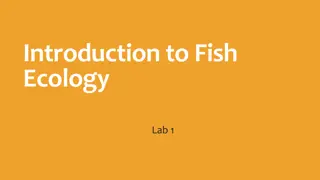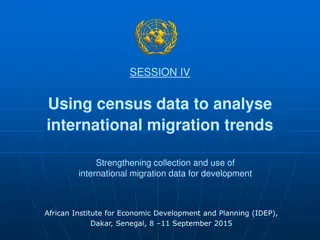Understanding Fish Migration Dynamics in River Environments
Delve into the intricate relationship between fish migration, survival rates, and in-river environments as explored by presenter Steve Haeseker from ODFW. Discover how factors like reservoirs, currents, and water transit times impact the journey of juvenile fish as they migrate upstream to downstream. Gain insights into the challenges posed by dam constructions and long-term changes in water transit times within the Lewiston-BON area.
Download Presentation

Please find below an Image/Link to download the presentation.
The content on the website is provided AS IS for your information and personal use only. It may not be sold, licensed, or shared on other websites without obtaining consent from the author. Download presentation by click this link. If you encounter any issues during the download, it is possible that the publisher has removed the file from their server.
E N D
Presentation Transcript
Survival, travel time and the in-river environment Presenter: Steve Haeseker ODFW Logo 1
Juvenile migration Two simultaneous processes: migration and mortality Migration (Fish Travel Time) Mortality How does the in-river environment affect fish travel time and survival? 2
Question: Do smolts generally face upstream or downstream as they migrate to sea? Current Ocean
Question: Do smolts generally face upstream or downstream as they migrate to sea? Current Ocean
Question: Do smolts generally face upstream or downstream as they migrate to sea? Answer: upstream Current Ocean
How do reservoirs affect the currents that fish rely on? Un-impounded velocity = 7 miles/hour 6
How do reservoirs affect the currents that fish rely on? Impounded velocity = 0.7 miles/hour 7
How do reservoirs affect the currents that fish rely on? Impounded velocity = 0.7 miles/hour 8
Water Transit Time (WTT) Estimate of the number of days required for average water particle to transit a reservoir (volume/flow) 3 days 2 days 2 days 7 days 9
Long-term changes in Lewiston-BON WTT 40 35 30 25 WTT 20 15 10 ~2 days 5 0 1925 1935 1945 1955 1965 1975 1985 1995 2005 2015 Migration Year 10
Long-term changes in Lewiston-BON WTT 40 35 dam construction 30 25 WTT 20 15 10 ~2 days 5 0 1925 1935 1945 1955 1965 1975 1985 1995 2005 2015 Migration Year 11
Long-term changes in Lewiston-BON WTT ~20 days 40 35 dam construction 30 25 WTT 20 15 10 ~2 days 5 0 1925 1935 1945 1955 1965 1975 1985 1995 2005 2015 Migration Year 12
Characterizing fish passage through dams PowerHouse passage experiences (PITPH) Incorporates spill proportion, flow, and spillway surface passage Powerhouse = Turbines + collection/bypass system Spillway = 1 - Powerhouse Percent powerhouse Percent spill 15
Powerhouse passages for Snake River migrants 8 6 Chinook Steelhead PITPH 4 2 0 1998 2001 2004 2007 2010 2013 2016 14
Objectives: Measure and monitor yearling Chinook and steelhead travel time and survival through the hydrosystem Examine associations between environmental factors and fish travel time and survival Develop models that explain variation in travel time and mortality rates through the hydrosystem 15
Monitoring methods: Yearling Chinook salmon and steelhead 16
Fish Travel Time (LGR-BON) 50 Steelhead 40 30 20 10 0 1998 2002 2006 2010 50 Yearling Chinook 40 30 20 10 0 17 1998 2001 2004 2007 2010
Juvenile Survival (LGR-BON) 1.0 Steelhead 0.8 0.6 0.4 0.2 0.0 1999 2002 2005 2008 2011 2014 1.0 Yearling Chinook 0.8 0.6 0.4 0.2 0.0 18 1999 2002 2005 2008 2011 2014
Survival 20
Fish Travel Time (LGR-BON) 50 Steelhead R2 = 0.96 40 30 20 10 0 1998 2002 2006 2010 50 Yearling Chinook R2 = 0.92 40 30 20 10 0 21 1998 2001 2004 2007 2010
Juvenile Survival (LGR-BON) Steelhead R2 = 0.69 1.0 0.8 0.6 0.4 0.2 0.0 1999 2002 2005 2008 2011 2014 1.0 Yearling Chinook R2 = 0.26 0.8 0.6 0.4 0.2 0.0 22 1999 2002 2005 2008 2011 2014
What are the spatial and temporal patterns in survival for Snake River stocks compared to other stocks in the Columbia River Basin? Species: Wild spring/summer (yearling) Chinook salmon Wild steelhead Timeframe: Juvenile outmigration years 2000-2012 Tools: Mark-recapture methods using PIT tags 330K steelhead, 1.1 million Chinook salmon tags
Study Area Snake 1-3 years Yakima John Day
Freshwater survival steelhead Chinook salmon Mean: 85% >> 57% > 48% Mean: 81% >> 60% > 54%
Ocean survival steelhead Chinook salmon Mean: 10.2% > 7.0% >> 3.8% Mean: 6.0% 5.4% >> 2.5%
Smolt-to-Adult survival steelhead Chinook salmon Mean: 5.6% 5.6% >> 2.1% Mean: 4.4% 3.7% >> 1.4%
Study Area Snake Yakima John Day
Variable environmental conditions Freshwater Water Transit Time Powerhouse Passages
Variable environmental conditions Marine Winter Icthyoplankton Pacific Decadal Oscillation
Variable environmental conditions Freshwater Marine Winter Water Transit Time Icthyoplankton Powerhouse Passages Pacific Decadal Oscillation
Variable environmental conditions -2 -2 J Chinook J JJJJ J Chinook Y JJJ J J J Y Y Y Y JJ J Y Y J J J J JJJ J J J YYY Y YYY S S S S S S Y Y Y S Y YY Y S Y S -4 -4 S S Y S S S S S S Y S S S S S -6 -6 S S S S -8 -8 Log (SAR) ) 0 2 4 6 8 0 5 10 15 20 25 30 -2 -2 Steelhead Steelhead JJ JJJJ J Y J Y J Y Y YY Y JJ J Y Y Y Y Y Y Y Y Y Y J Y J Y J J Y S S S S J J S S Y Y S S S S S SS S -4 -4 S S S S S S -6 -6 S S S S S S -8 -8 0 2 4 6 8 0 5 10 15 20 25 30 Powerhouses Water Transit Time
What factors are associated with the patterns in survival? Multiple regression with multi-model inference Smolt-to- Adult survival Freshwater survival Ocean survival Variables Water Transit Time Powerhouse passages Average dissolved gas Stock Winter Ichthyoplankton Pacific Decadal Oscillation
Fitted freshwater survival steelhead Chinook salmon R2 = 0.60 R2 = 0.85
Fitted ocean survival steelhead Chinook salmon R2 = 0.87 R2 = 0.70
Fitted Smolt-to-Adult survival steelhead Chinook salmon R2 = 0.90 R2 = 0.79
Relative Variable Importance steelhead Chinook salmon Freshwater survival Ocean survival Smolt-to- Adult survival
Can management efforts help achieve regional survival goals? Use model-averaged coefficients to forecast Smolt-to- Adult survival rates Considered two management scenarios: Current Biological Opinion spill levels Spill to 125% dissolved gas limits Account for variable freshwater and ocean conditions: High, average, low flow years Winter Ichthyoplankton, Pacific Decadal Oscillation
Predicted Smolt-to-Adult survival rates: Chinook salmon Prob. (< 1% SAR): 38% 5%
Predicted Smolt-to-Adult survival rates: steelhead 26% 0% Prob. (< 1% SAR):
Conclusions Models captured high degree of spatial and temporal patterns in variation Freshwater: Powerhouses + Water Transit Time Ocean: Powerhouses + Water Transit Time + Ichthyoplankton + PDO Smolt-to-Adult: Powerhouses + Water Transit Time + Ichthyoplankton + PDO Snake: 230% - 250% improvement in Smolt-to-Adult survival with increased spill Yakima: 50% - 60% improvement John Day: 30% - 50% improvement Adaptive Management Experiment: Ongoing tagging efforts provides framework for monitoring























